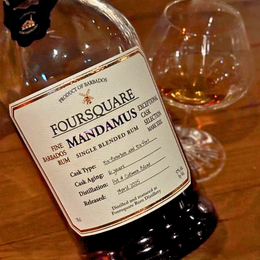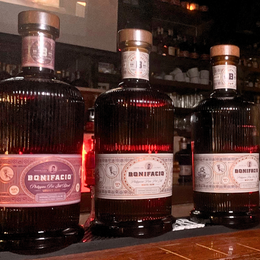
One of the interesting (and slightly obscure) features of whiskies and rums within the spirits realm is that if you're observant, you'll notice that vintages of these spirits tend to appear in waves. A whole bunch of whiskies or rums from a select year (the vintage) will tend to suddenly show up across both the distillery itself, and more conspicuously in the various stables of independent bottlers (IBs). And very much like the natural feature of a wave, it'll come all at once and then completely disappear - and so you'll tend to notice folks rave about a specific vintage from a specific distillery for a short period of time and then before you know it, it's over.
This means that materially, when you notice this wave happening, the best thing you can do as the spirits aficionado that you are is to give a couple of them a taste across the various IBs, and if available the OB as well, and figure if you like them or not - because if you do, you'll want to quickly stock up on these while you're still in the midst of the wave before it's over! On occasion these waves will yield some legendary (or at the least revered) expressions and once it's past, be prepared to pay a pretty penny for it, and more realistically from personal experience, these tend to simply be completely out of circulation (which means you couldn't even buy it even if you were willing to pay for it).


You probably know Angostura best from its bitters.
So why do I say all of this? Well, because I think one of the waves happening right now is that of the early 2000's TDL rums from Trinidad. These early millennium Trinidads from what is effectively Angostura (also of Bitters fame) all consistently express an incredibly delectable tropical lychee and longan aroma and flavour that is simply incredible. They are immensely fruity, spanning confectionary tinned fruits to more musky and leafy fresh off the vine fruits, and on such a rare occasion translates perfectly from aroma to the palate. Often it is said that the nose fools, by which many seasoned consumers will bemoan that a spirit tends to have great aromas but falls short on the actual taste itself. In this case, that could not be more untrue - here we have a perfect example of great aromas, amazing flavours, superb body, awesome complexity and a damn fine finish. These are unicorns in the making - I'll put it out there right now.
How do these waves happen you might (and should) ask? Typically it would go something like this: a distillery has some barrels to put on sale/auction from a particular year's batch - this may occur for a variety of reasons. Sometimes it's because they have excess inventory, or perhaps the flavour profiles don't fit snugly into the distillery's house style (which might be due to a change in fermentation, distillation, or cask program a particular year), or simply because the distillery may wish to raise sales. Thus cask brokers are called in to take these barrels off the hands of the distillery. These brokers in turn sell the casks to a range of independent bottlers who then bottle these. Typically based on the warmth of their relationship with the broker, these IBs will get a better or not so good range to select from. This is of course a non-exhaustive example of how such a wave might occur, but would account for the majority of the times it does.

Angostura's flagship rums.
And so really in that sense, such a wave has great potential for creating some renowned expressions simply because they typically occur atypically at the distillery-level, and therefore appears as a wave, and once folks catch on (which bear in mind, takes quite some bottle opening to happen, thereby reducing availability as well!), the fervour is on, and before you know it, all of it is gone. Thus it pays to spot a wave quickly and get your fill.
Now, you might keenly ask why it is that a distillery might want to get rid of a specific batch of casks - and does that mean these are therefore of poor quality. Well, not necessarily, if they were bad, it would be unlikely that cask brokers would commit to buy large quantities of them anyway. And so what typically happens is that a distillery may test out a new configuration, a new process, or run experiments as I mentioned earlier - the thing is spirits don't completely express themselves in full until they're several years matured. Thus factoring in the angel's share, it would only be economical for the distillery to produce a rather substantial batch each run of an experiment for it to be worth the while.

The Angostura Distillery in Trinidad. (Image Source: AFAR)
Several years pass, and it becomes clear that the spirit is actually pretty good, heck it might even be amazing, however, it completely falls outside the distillery's house style and so they can't ensure consistency in their flagship - the last thing they would want is for a specific year's core release to be incredible and atypical, and then after which it reverts back to the usual - what a way to piss off fans! What about a special one off release - well, you'll notice this has increasingly been the case for Scotch distilleries with big budgets (I'm looking at you Ardbeg), however, with rum distilleries that aren't nearly as well-funded or as adept at marketing and distribution, it's perhaps far less risky and easier to pass it along to a cask broker.
And then we get to the second pro tip from a person who has unfortunately seen his fair share of waves pass him by, is to go with reputable IBs. As mentioned, what an IB gets to pick from is very much dependent on their relationship with the distillery, and more often than not, the cask brokers - if they're of good standing, they'll typically get first pick, and so on and so forth. Which underscores the value of an IB in any case.
With all of that said, today we've got a TDL 2002 from Angostura, which itself is a complicated beast, which we've already seen in a couple of instances as being a stellar vintage.

A Vendome still.
For those not yet caught up, Angostura is most well-known for its bitters, but in order to make its bitters, it requires rum as a base product. What started out with them procuring rum in bulk to make their bitters, eventually turned into them deciding it was more cost effective to simply make their own rum for their bitters-making. As a result you'll see that the Angostura brand has its own flagship line of rums. However, what you won't see unless you look around the IBs, is the TDL labelled rum, which also comes from Angostura but is not labelled as such as Angostura doesn't do single casks, and simply keeps to their core flagship line - it's simpler and easier that way to maintain a consistent global brand. Thus TDL is always going to be rum from Angostura that's bottled by independent bottlers as a result of the process detailed above.
As to the question of why it is that Angostura-made rums in the early millennium are unusually outstanding, I have wondered if this was because of the temporary (sort of experimental) use of the Vendome batch still. See in 2000, the Trinidadian distillery toyed with the use of a Vendome batch still that's a hybrid of a pot and column still (that's being reductive but for simplicity's sake) - the distillery produced several runs of rum, and yet by 2003 was decided that they didn't quite jive with what it produced, and so having shared the same parent company as St. Lucia Distillers, passed it along to them, who too have begun producing rums that are quietly sleeper hits. Thus if you think about it, this is a wave that has a swell that lasted from 2000 - 2003, and we're thus seeing them being bottled by IBs since around late 2022. In one notable rum-focused forum, it's been commented that rums under the TDL banner from pre-2000 and post-2003 haven't quite been the same.

Which brings us finally to our bottle at hand - the TDL 2002 bottled by The Wild Parrot. The Wild Parrot is an Italian IB - the Italians really have a solid IB culture frankly, and was founded between Stefano Cremaschi, who runs a Milanese spirits store The Whisky Roundabout, and Andrea Ferrari, who heads another IB, Hidden Spirits. And thus you'll find The Wild Parrot being closely linked with Hidden Spirits. A quick look at their portfolio should easily impress any rum lover, with the IB having bottled no small number of pretty big name rums. What's also of particular interest is that The Wild Parrot shares the same muscular broad shouldered opaque black bottle as famed fellow Italian IB Velier - I wonder what the link is there.
In any case, we've got a very well-aged 20 Year Old TDL 2002 from Trinidad Distillers (or Angostura) that's bottled by The Wild Parrot - let's get to it!
The Wild Parrot Trinidad TDL 2002, 20 Year Old, 59.1% ABV - Review

Tasting Notes
Color: Honey
Aroma: Super tropical - mangoes, lychees - somewhere between still on the vine lychees (lightly vinous and musky) and tinned lychees (sweeter and more estery) - really estery. There’s even honey topped off on top of these vinous and vegetal, confectionary and sweet scents. Some fruit nectar too, and a lighter bit of grass jelly.
Taste: As you would hope, lots of lychee - really estery, with a dash of salt, and also slightly vegetal of vines. It’s still punchy, packing pepper, lots of heat, but oh so fruity. Back up by more honey, still really sweet, more on brown sugar, but also leafy and of woody vines.
Finish: More earthy here - tobacco leaves, more ashy too, and also quite herbal, with notes of tortoiseshell jelly, brown sugar, honey, and alittle bit of yogurt. Lingering drying quality.

My Thoughts
Pretty damn phenomenal! This was spectacular as is increasingly to be expected by 2000’s TDLs which are so slept on right now, but fast being taken noticed of. This balances splendidly the confectionary sweet tinned lychees and also the more leafy, vegetal fresh lychees still on the vine - this runs right down the middle. It skilfully avoids ever being too sweet, tannic, dry or just being boring.
It has a great aroma, flavours, texture and complexity that becomes prominent into the finish - even with a side of more herbal and earthy flavours. Absolute banger!
My Rating: 10/10
Score/Rating Scale :
- 9-10 : Exceptional, highly memorable, 10/10 would buy if I could.
- 7-8 : Excellent, well above most in its category, worth considering buy-zone.
- 4-6 : Good, okay, alright; a few flaws, but acceptable; not bad, but not my personal preference; still worth trying, could be a buy if the price is right.
- 1-3 : Not good; really did not enjoy; wouldn't even recommend trying.
- 0 : Un-scored, might be damaged, new make, or very unusual.
Kanpai!

@111hotpot







